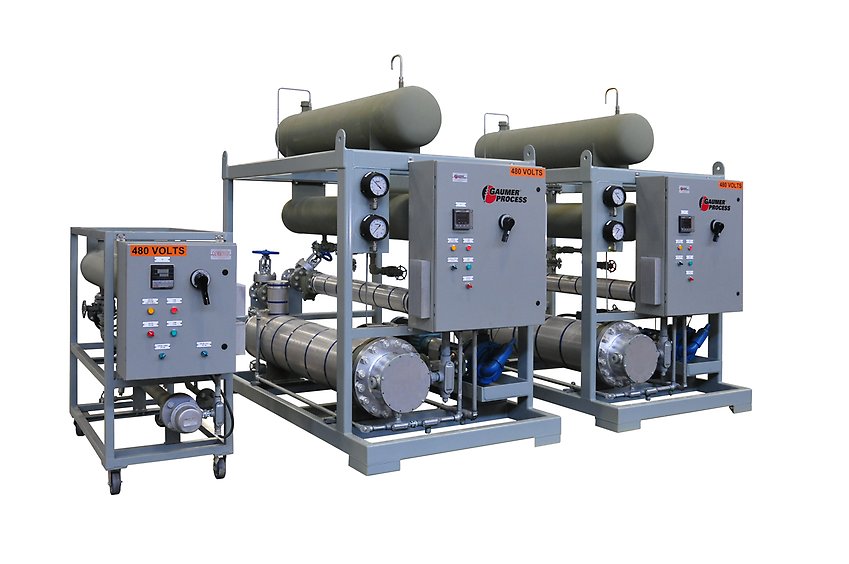How DVS Heat Transfer Systems Support Lifecycle Sustainability from Design to Disposal
Wiki Article
The Function of Heat Transfer Equipments in Sustainable Power Solutions for the Future
Heat transfer systems are vital in the pursuit for sustainable power solutions. They optimize thermal power monitoring, enhancing the effectiveness of eco-friendly modern technologies. By utilizing systems like convection, transmission, and radiation, these systems reduce power losses. Their role in solar thermal and geothermal applications is especially considerable. As advancements emerge, the potential for additional improvements elevates crucial inquiries regarding future power strategies. What developments will shape the landscape of lasting energy?Recognizing Heat Transfer Systems

The Significance of Thermal Power Monitoring
Reliable thermal power administration is necessary for making best use of power performance and decreasing waste in numerous systems. By managing temperature and enhancing Heat transfer procedures, companies can significantly lower power consumption and functional prices. Effective administration includes the application of sophisticated modern technologies and methods that check and manage thermal conditions within systems, making sure that power sources are utilized effectively. On top of that, appropriate thermal energy management contributes to reducing greenhouse gas exhausts, aligning with global sustainability objectives. It additionally boosts system reliability and efficiency, leading to enhanced product high quality and longer tools life-span. Inevitably, focusing on thermal power administration is a vital action in the direction of producing extra sustainable power remedies and promoting a liable approach to energy usage in commercial and domestic contexts.Applications of Heat Transfer in Renewable Resource
While numerous renewable energy resources assure sustainability, the efficient application of Heat transfer plays a crucial role in their efficiency. In wind power systems, Heat transfer is utilized for turbine element air conditioning, boosting efficiency and longevity. Geothermal energy depends on efficient Heat exchange in between the planet's subsurface and the liquid flowing in the system, optimizing power removal. Biomass energy processes also benefit from Heat transfer, as it helps in converting organic materials into functional gas via pyrolysis and gasification. Furthermore, in hydropower, preserving excellent temperature levels in storage tanks can improve power result. Each of these applications shows the essential importance of Heat transfer systems in enhancing renewable resource technologies, ultimately contributing to a more lasting power future.Enhancing Solar Thermal Power Performance
As solar thermal power systems proceed to progress, enhancing their efficiency has actually come to be crucial for maximizing power result. Advances in Heat transfer technologies, such as boosted thermal storage space materials and innovative Heat exchangers, play a considerable function in boosting efficiency. By using innovative products that have remarkable thermal conductivity, systems can transfer and capture Heat better. Furthermore, integrating radar that follow the sun's course warranties that enthusiasts get ideal solar direct exposure throughout the day. Utilizing nanotechnology in solar absorbers can additionally raise energy absorption rates. Moreover, incorporating computerized control systems aids handle and regulate temperature levels energy circulation effectively, resulting in reduced losses and enhanced overall system effectiveness. These improvements lead the way for even more sustainable solar thermal power solutions in the future.Geothermal Heating: A Lasting Solution
Geothermal heating offers a practical choice for lasting energy, using substantial environmental benefits via reduced greenhouse gas discharges. Its performance and cost-effectiveness make it an attractive option to typical heater. Nevertheless, obstacles connected to implementation should be dealt with to optimize its potential impact.Ecological Benefits of Geothermal
Conventional heating techniques contribute considerably to greenhouse gas exhausts, geothermal home heating offers an engaging choice that lessens ecological effect. By utilizing the Earth's internal Heat, geothermal systems make use of an eco-friendly energy resource, noticeably minimizing dependence on nonrenewable fuel sources. This technique generates marginal carbon exhausts, making it a cleaner choice for business and property heating. Furthermore, geothermal systems advertise energy effectiveness, as they call for less power compared to conventional heating unit. DVS Heat Transfer Systems. The use of geothermal power likewise helps in lowering air pollution, boosting local air top quality and public health and wellness. As a sustainable solution, geothermal home heating supports climate change mitigation initiatives, positioning itself as an essential part in the shift towards a greener futureEfficiency and Cost-Effectiveness
Exactly how does geothermal home heating determine up in regards to effectiveness and cost-effectiveness contrasted to traditional furnace? Geothermal home DVS Heat Transfer Systems heating shows superior effectiveness, usually accomplishing a coefficient of efficiency (COP) of 3 to 5, meaning it creates 3 to five units of Heat for every single unit of electrical energy eaten. This performance translates into reduced operating costs, particularly in areas with steady geothermal sources. First installment costs can be more than standard systems; nonetheless, long-term cost savings on power costs and reduced maintenance costs can balance out these ahead of time financial investments. Additionally, numerous governments incentivize geothermal systems with discounts and tax obligation credit scores, enhancing their cost-effectiveness. In general, geothermal heating becomes a lasting and financially feasible choice to even more standard heating solutions.Implementation Difficulties and Solutions
Many obstacles can restrain the prevalent execution of geothermal heater, regardless of their clear benefits as a lasting power solution. High first installment expenses typically discourage house owners and financiers, making financing a significant barrier. In addition, the geographical constraints of ideal geothermal websites limit ease of access in specific regions. Local regulations and allowing procedures can likewise complicate project growth, bring about hold-ups. In addition, public recognition and understanding of geothermal systems remain reduced, impeding acceptance. To deal with these challenges, targeted education and learning projects can enhance open secret, while federal government incentives can ease financial burdens. Teaming up with local authorities to simplify guidelines may assist in smoother project authorizations, ultimately advertising the adoption of geothermal home heating as a practical, lasting energy alternative.Advancements in Heat Transfer Technologies
Advancements in Heat transfer innovations play an essential function in boosting energy efficiency and sustainability. Advanced Heat exchangers and stage change products go to the forefront of these advancements, offering significant renovations in thermal administration. These modern technologies not only enhance power usage but likewise add to decreasing ecological impact in different applications.Advanced Heat Exchangers
Advanced Heat exchangers play a vital duty in enhancing energy effectiveness throughout various applications in sustainable energy remedies. These devices help with the transfer of Heat in between 2 or more fluids, noticeably lowering energy usage in processes such as commercial home heating, air conditioning, and power generation. Technologies in materials and design, such as the use of nanofluids and small setups, have actually led to enhanced thermal efficiency and reduced size demands. Furthermore, innovations in electronic monitoring and control systems allow for enhanced operation, more increasing efficiency. By minimizing waste Heat and making best use of energy recovery, advanced Heat exchangers add to decrease carbon impacts and sustain the change towards eco pleasant modern technologies. Their proceeded development is vital for attaining worldwide power sustainability objectives.
Phase Change Products
The assimilation of phase change products (PCMs) right into Heat transfer innovations represents a significant development in power monitoring and effectiveness. PCMs absorb and launch thermal power during their stage adjustments, allowing effective temperature level guideline in building products and power systems. By storing excess Heat during peak durations and releasing it when demand rises, PCMs add to load changing and energy preservation - DVS Heat Transfer Systems. This ability enhances the efficiency of sustainable power systems, especially in solar thermal applications. Additionally, PCMs can boost the thermal comfort of interior atmospheres, decreasing reliance on traditional heating and cooling down methods. As advancements in PCM formulations proceed to emerge, their function in lasting power options is positioned to grow, supplying promising methods for future study and application
Future Prospects for Heat Transfer in Lasting Power
As the demand for lasting power options remains to increase, the role of Heat transfer systems is becoming increasingly critical fit future innovations. Developments in layouts and products are anticipated to enhance effectiveness in Heat transfer, minimizing energy losses in different applications. The combination of sophisticated thermal storage systems, such as stage change materials and thermochemical storage, will certainly allow far better management of power resources. Research study into nanofluids and biomimetic Heat exchangers might even more enhance thermal performance. The adoption of smart technologies will permit for real-time tracking and flexible control of Heat transfer procedures. These improvements are poised to considerably add to the total effectiveness and sustainability of power systems, leading the way for a more energy-efficient future.Regularly Asked Questions
Exactly How Can Individuals Carry Out Heat Transfer Systems in the house?

Individuals can carry out Heat transfer systems at home by mounting energy-efficient appliances, using radiant heat, and enhancing insulation. These actions enhance energy performance, reduce expenses, and advertise sustainable methods in household environments.

What Are the Prices Connected With Setting Up Heat Transfer Equipments?
The expenses associated with mounting Heat transfer systems vary extensively, normally including equipment, installment labor, and maintenance. Factors such as system kind, home size, and neighborhood guidelines significantly influence the general expense included.Exist Government Incentives for Heat Transfer System Installations?
Federal government rewards for Heat transfer system installations differ by region and can consist of tax credit reports, refunds, and gives. These economic benefits intend to encourage fostering, inevitably promoting power performance and decreasing ecological effect within areas.Exactly How Do Heat Transfer Equipments Impact Energy Expenses?
Heat transfer systems notably influence energy bills by maximizing energy effectiveness. By enhancing the transfer of Heat, these systems reduce energy consumption, causing reduced energy expenses and developing a more sustainable method to energy administration.What Upkeep Is Required for Heat Transfer Equipments?
Maintenance for Heat transfer systems includes regular evaluations, cleaning of elements, inspecting liquid degrees, ensuring appropriate insulation, and changing used components. These jobs assist keep performance, protect against breakdowns, and prolong the system's operational lifespan.These systems facilitate the movement of thermal energy from one tool to an additional, making it possible for the transfer of Heat for power, cooling, or heating generation purposes. Geothermal energy counts on reliable Heat exchange between the earth's subsurface and the liquid flowing in the system, maximizing power removal. Furthermore, geothermal systems promote power performance, as they need less power contrasted to traditional heating systems. Advanced Heat exchangers play a crucial duty in improving energy performance throughout various applications in lasting power services. Heat transfer systems significantly influence power expenses by optimizing energy performance.
Report this wiki page